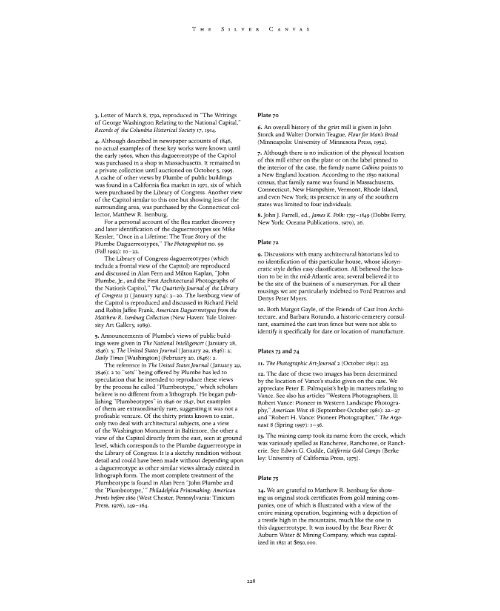The Silver Canvas - Daguerrotype Masterpieces (Art Photography Ebook)
Create successful ePaper yourself
Turn your PDF publications into a flip-book with our unique Google optimized e-Paper software.
T H E S I L V E R C A N V A S<br />
3. Letter of March 8,1792, reproduced in "<strong>The</strong> Writings<br />
of George Washington Relating to the National Capital,"<br />
Records of the Columbia Historical Society 17,1914.<br />
4. Although described in newspaper accounts of 1846,<br />
no actual examples of these key works were known until<br />
the early 19605, when this daguerreotype of the Capitol<br />
was purchased in a shop in Massachusetts. It remained in<br />
a private collection until auctioned on October 5,1995.<br />
A cache of other views by Plumbe of public buildings<br />
was found in a California flea market in 1971, six of which<br />
were purchased by the Library of Congress. Another view<br />
of the Capitol similar to this one but showing less of the<br />
surrounding area, was purchased by the Connecticut collector,<br />
Matthew R. Isenburg.<br />
For a personal account of the flea market discovery<br />
and later identification of the daguerreotypes see Mike<br />
Kessler, "Once in a Lifetime: <strong>The</strong> True Story of the<br />
Plumbe Daguerreotypes," <strong>The</strong> Photographist no. 99<br />
(Fall 1993): 10-22.<br />
<strong>The</strong> Library of Congress daguerreotypes (which<br />
include a frontal view of the Capitol) are reproduced<br />
and discussed in Alan Fern and Milton Kaplan, "John<br />
Plumbe, Jr., and the First Architectural Photographs of<br />
the Nations Capitol," <strong>The</strong> Quarterly Journal of the Library<br />
of Congress 31 (January 1974): 3-20. <strong>The</strong> Isenburg view of<br />
the Capitol is reproduced and discussed in Richard Field<br />
and Robin Jaffee Frank, American Daguerreotypes from the<br />
Matthew R. Isenburg Collection (New Haven: Yale University<br />
<strong>Art</strong> Gallery, 1989).<br />
5. Announcements of Plumbe s views of public buildings<br />
were given in <strong>The</strong> National Intelligencer (January 28,<br />
1846): ^; <strong>The</strong> United States Journal (January 29,1846): 2;<br />
Daily Times [Washington] (February 20,1846): 2.<br />
<strong>The</strong> reference in <strong>The</strong> United States Journal (January 29,<br />
1846): 2 to "sets" being offered by Plumbe has led to<br />
speculation that he intended to reproduce these views<br />
by the process he called "Plumbeotype," which scholars<br />
believe is no different from a lithograph. He began publishing<br />
"Plumbeotypes" in 1846 or 1847, but examples<br />
of them are extraordinarily rare, suggesting it was not a<br />
profitable venture. Of the thirty prints known to exist,<br />
only two deal with architectural subjects, one a view<br />
of the Washington Monument in Baltimore, the other a<br />
view of the Capitol directly from the east, seen at ground<br />
level, which corresponds to the Plumbe daguerreotype in<br />
the Library of Congress. It is a sketchy rendition without<br />
detail and could have been made without depending upon<br />
a daguerreotype as other similar views already existed in<br />
lithograph form. <strong>The</strong> most complete treatment of the<br />
Plumbeotype is found in Alan Fern "John Plumbe and<br />
the 'Plumbeotype/ " Philadelphia Printmaking: American<br />
Prints before 1860 (West Chester, Pennsylvania: Tinicum<br />
Press, 1976), 149-164.<br />
Plate 70<br />
6. An overall history of the grist mill is given in John<br />
Storck and Walter Dorwin Teague, Flour for Man's Bread<br />
(Minneapolis: University of Minnesota Press, 1952).<br />
7. Although there is no indication of the physical location<br />
of this mill either on the plate or on the label pinned to<br />
the interior of the case, the family name Calkins points to<br />
a New England location. According to the 1850 national<br />
census, that family name was found in Massachusetts,<br />
Connecticut, New Hampshire, Vermont, Rhode Island,<br />
and even New York; its presence in any of the southern<br />
states was limited to four individuals.<br />
8. John J. Farrell, ed., James K. Polk: 1795-1849 (Dobbs Ferry,<br />
New York: Oceana Publications, 1970), 26.<br />
Plate 72<br />
9. Discussions with many architectural historians led to<br />
no identification of this particular house, whose idiosyncratic<br />
style defies easy classification. All believed the location<br />
to be in the mid-Atlantic area; several believed it to<br />
be the site of the business of a nurseryman. For all their<br />
musings we are particularly indebted to Ford Peatross and<br />
Denys Peter Myers.<br />
10. Both Margot Gayle, of the Friends of Cast Iron Architecture,<br />
and Barbara Rotundo, a historic-cemetery consultant,<br />
examined the cast iron fence but were not able to<br />
identify it specifically for date or location of manufacture.<br />
Plates 73 and 74<br />
11. <strong>The</strong> Photographic <strong>Art</strong>-Journal 2 (October 1851): 253.<br />
12. <strong>The</strong> date of these two images has been determined<br />
by the location of Vance s studio given on the case. We<br />
appreciate Peter E. Palmquist s help in matters relating to<br />
Vance. See also his articles "Western Photographers, II:<br />
Robert Vance: Pioneer in Western Landscape <strong>Photography</strong>,"<br />
American West 18 (September-October 1981): 22-27<br />
and "Robert H. Vance: Pioneer Photographer," <strong>The</strong> Argonaut<br />
8 (Spring 1997): 1-36.<br />
13. <strong>The</strong> mining camp took its name from the creek, which<br />
was variously spelled as Rancheree, Ranchoree, or Rancherie.<br />
See Edwin G. Gudde, California Gold Camps (Berkeley:<br />
University of California Press, 1975).<br />
Plate 75<br />
14. We are grateful to Matthew R. Isenburg for showing<br />
us original stock certificates from gold mining companies,<br />
one of which is illustrated with a view of the<br />
entire mining operation, beginning with a depiction of<br />
a trestle high in the mountains, much like the one in<br />
this daguerreotype. It was issued by the Bear River &<br />
Auburn Water & Mining Company, which was capitalized<br />
in 1851 at $650,000.<br />
228


